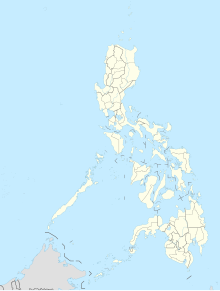Kabayan mummies
Coordinates: 16 ° 33 ' N , 120 ° 45' E
Kabayan mummies are named after their location in the municipality of Kabayan in the province of Benguet , Philippines . Kabayan is considered a center of the Ibaloi culture, the traces of which can be traced back to the pre-colonial era. A sociological peculiarity of the historical Ibaloi culture is the mummification of selected and socially important dignitaries.
The mummification that the Ibaloi performed was an active method of making mummies . This method is known as fire mummification. Shortly before the death of the person concerned, preparations for mummification were initiated by giving the person concerned high-salt and alkaline drinks. After the death, the body was positioned in a sitting position over a fire of low to medium intensity until the body was completely dehydrated from the heat treatment . This process could take up to two years. At the end of the treatment, the old layers of skin were removed and the body was embalmed with plant extracts, and the body was also subjected to an intensive tobacco smoke treatment. This type of mummification was carried out from the 10th to the 16th century and is considered the second example of active mummification of the dead worldwide, which was carried out using a different technique than mummification in ancient Egypt .
The mummies were then buried in wooden coffins that were laid out in man-made and natural caves. These caves are considered sacred ground by the Ibaloi and are located near Mount Pulag National Park . The burial grounds of Kabayan Mummies are since 2006 on the proposed list of the Philippines for inclusion on the World Heritage List of UNESCO and are considered National Heritage of the Philippines.
See also
Other Archaeological Dig Sites in the Philippines
- Arubo archaeological site
- Archaeological dig sites in the Cagayan Valley
- Butuan City Archaeological Dig Site
- Petroglyphs in the Philippines
